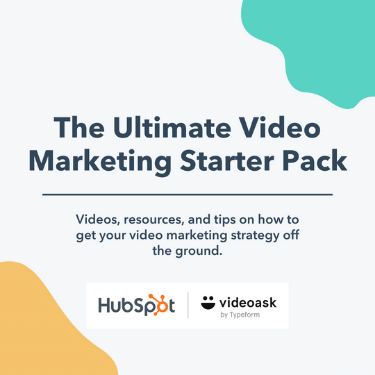Although creating, organizing, and editing compelling videos can be lengthy and scary, a good script can make or break the success of your video.
So, why don’t we take you through the steps on how you can start your scriptwriting process?
Any basic video is elevated with a script, but there’s more to creating a video. You’ll need proper equipment, sound, lighting, sets, and the cast and crew. When combining these, it can be challenging to make sure there are no mistakes.
A strong video script can seamlessly bring it all together. Plus, having an in-depth script will boost your team's confidence and result in a better video outcome.
1. Choose your target audience.
Any marketing project is better with the right buyer persona. This is especially true with video.
Because videos often take more time and investment than an online ad or blog, your video must speak to a specific audience.
So, before you start developing characters or a brief for your video, you need to figure out who your video is for. Your target audience for your video script can impact:
- The length and format of your video.
- Where you post your video.
- Setting, costume, and lighting.
If your video is for brand awareness, you may broadcast to a large and diverse audience. But what if you‘re introducing a product or feature?
In that case, you’ll want to focus your audience on the buyers who are most likely to feel the pain point your product solves.
You might want a different approach if your video is for employee or customer retention. You'll want to review data, reviews, and testimonials before you begin your script brief.
This will help you create the story and dialogue your audience will respond to.
2. Set a goal for your video script.
Videos are usually team projects. Without a single focus, every person could come to the video with their idea of what it's about. As the project continues, this can turn a simple video into a convoluted mess.
That's why starting your video script is essential by just thinking about your goal. So, before you jump into a storyline, character, or setting, figure out the why.
Why are you making this video?
Do you want to teach people about your product? Are you introducing a new pricing structure? Are you trying to expand into a new niche?
If you‘re not sure about your goal, think about the problem you’re hoping this video will solve.
For example, say you're struggling with conversions for a new product.
- Is it because you're breaking into a new niche? A product video on the right social media platform for this niche might be right.
- Do users need better instructions? You might want to add a product tour or instructional video to your website.
- Are you getting good reviews? You may want to partner with influencers to build a reputation for this product.
Don't jump into your video script without deciding on a single goal.
Then, use your goal to set the metrics you‘ll use to measure the video’s performance once it goes live.
3. Choose the main character for your video.
Video marketing helps you show your viewers what your product can do instead of telling them. And characters are essential to storytelling.
Choosing the main character for your video before you begin your script will help you focus on telling a story, not just selling an idea. This will help your audience connect and engage with your video.
You may already know that your main character is your ideal customer or your CEO. They could be a celebrity, a cartoon of your product, or a narrator who speaks in your brand voice.
But if not, before you start writing your video script, decide who will be the focus of your video.
If you don't know who your main character is, go back to your goal and target audience. Think about who your buyer persona wants to hear from as they reach that stage of their journey.
Next, outline your main character. You can use the habits, quirks, and voice of your main character to paint a picture for your audience that helps them remember and relate to your video.
Once you've figured out your main character, you can decide how they relate to your product. Do you want to talk about their back story? Are you going to talk about a specific experience they had and how your product helped?
4. Create a brief.
Creating a brief allows you and your team to document the answers to the most important project questions. This helps everyone involved understand the who, what, when, where, and why of your video.
Say you‘re three-quarters of the way through the editing process. If your boss or colleague wants to completely redo half of your video, that’s a huge problem.
Challenges like this can impact your budget, timing, and campaigns. But with a brief, you can refer to the goals and project plan your team mapped out together and say, “Actually, that's not what we agreed to.”
Then, you can move forward.
Focus on your goals, topic, and takeaways in your brief.
A brief doesn't have to be fancy, nor does it have to follow a specific formula. However, there are several vital questions it should include to craft an effective video script.
- What‘s the video topic? (The more specific, the better. For example, if you’re in the house painting business, you might choose a topic like “buying the right paint brush.”)
- What are the key takeaways of the video? What should viewers learn from watching it?
- What‘s our call-to-action? What do we want viewers to do after they’ve finished watching the video?
You can easily create a brief in Google Docs to serve as a living, breathing template that you revise over time – and that your team can collaborate on. Once your brief is finalized, you can use HubSpot's Clip Creator to convert your text into a professional video for your business. This free, AI-powered tool, creates videos tailored to your business and vision without the expense of a production crew.
5. Use your brief to write an outline.
Once you‘ve picked a topic and written a brief, it’s time to start constructing your video script. We recommend starting with an outline to give structure to your video script.
This way, you can break your video into subtopics and decide how your dialogue (or monologue) will progress.
Are you basing your video script on a blog?
You can‘t just rewrite a blog post and call it a day – there’s a specific way to write a blog-based script so that it shapes an effective video. Alicia Collins can teach you a bit more in the video below (and yes, we wrote a script for it).
Like Alicia says in the video above, a video script shouldn‘t simply regurgitate the blog post word-for-word. Blog posts are ideally written to be conversational.
But there are pauses and verbal explanations you’ll need to add to your speech patterns that you wouldn’t have without your script.
But, using the blog post's subsections is a helpful starting point when figuring out how your script will progress from one section to the next.
Are you writing an original video script?
Start with a well-structured outline. Many video scripts follow a three-part structure that includes:
- An introduction and hook to draw viewers into your video.
- A problem, pain point, or question comes up.
- A conclusion and resolution of the problem, including a call to action.
This is a basic video script structure, but you can go in many ways as you outline your story. This structure will help you write a script that covers the details that make your video believable and valuable to your audience.
As you create your outline, think about where natural transitions happen.
For example, say you're writing a video script about the life of a new product. You might outline your script with the steps a business might take to launch a product, including:
- Coming up with the idea.
- Doing market research.
- Designing the new product.
- Producing a test product.
- Editing the product for mass production.
- Audience testing.
- Marketing and sales strategies.
- Product launch.
Your primary goal is to engage your target audience with a situation they can connect with. This can help them understand how the challenges you share in your video relate to the problems they want to solve in their own lives.
6. Start writing your script, section by section.
Your video script doesn‘t have to be fancy. You’re not trying to submit this script for any awards – its purpose is strictly functional.
A good script makes it easy for the people on camera to get their messages across while sounding and acting naturally.
Write conversationally.
Writing a script isn’t the same as writing a college paper or marketing research report. You want to write the script how you want the video subject to speak.
Saying, “I'm gonna create a video after reading this blog post” on camera will read much better than, “I am going to create a video after reading this blog post.” Keep sentences short and crisp, and try to avoid compound sentences.
Make it thorough.
A script doesn't just include dialogue. If your video will require multiple shots, characters, or scenes, include these details. Be sure to include any necessary information about the set or stage actions, such as a wardrobe change.
Basically, you want the script to be thorough enough that you could hand it off to someone else to shoot, and they'd understand it.
Write for the audience and the platform.
Make sure you‘re keeping your script conversational for the people you’re trying to connect with – and infuse humor, tone, and inflection accordingly.
For example, if you‘re writing a short-form video for Facebook, you might want to consider keeping your script choppier with sentence fragments.
But if you’re producing a long-form explainer video for your website, make sure you're as thorough as possible.
Script every single word.
It's understandable to think you can just jot down the main bullet points for a script and then just wing it on camera, especially if you know your subject matter.
This approach makes it tough to communicate a message as clearly and concisely as possible, and it usually results in a lot of redos.
So, we suggest scripting every last word. Doing this will keep you organized during filming and save you loads of time later.
7. Edit your video script.
Writing is tough, and it‘s easy to get stuck if you expect your video script to be perfect on your first draft. It’s worth doing two to three rounds of edits to cut any unnecessary words in your writing.
These are a few more tips for editing your script so that the video script can make your final video shine.
Give yourself a break.
Step away from your script after you write it, and don't go back until you can look at it from a fresh perspective.
Check for transitions.
Dialogue and actions will move your story forward. So, look for moments in your script that feel abrupt or awkward. Then, add details that will help your viewers understand what is happening.
Cut the extras.
Great writing and interesting dialogue will be bad for your video if they don't advance your story. Edit out these parts and save them for a later project if you think they can be useful.
8. Do a verbal run-through off-camera.
Now that you know how to write a script, it's time for a table read. This is the part where you practice bringing your script to life on camera.
Why practice? Because some words look great on paper, but once you read them aloud, they just don't sound right. Reading your video script out loud can help you make the language more conversational and your sentences shorter.
You can read your script aloud while editing, but the table read is where you really get to fine-tune the tone. It’s when you can mix anything that sounds too proper, improper, robotic, or otherwise inappropriate for the message you want to convey.
Check out this video for a fun example of a table read:
Video Script Template
Nothing is more frustrating than nervously trying to write an effective video script while staring at a blank sheet. It's easy to feel overwhelmed with all of the ideas floating around.
So, where do you even start? How do you sort and narrow all the ideas to write a strong screenplay? Furthermore, how do you direct this creative tempest into a script that engages the audience?
Well, starting with a template makes it that much easier. Here are some of our video marketing starter packs with a free video script template you can consider. Also, check out the HubSpot video below for more info.
Let’s explore multiple templates for different types of videos:
1. HubSpot’s All-in-One Video Script Template
You can modify scripts to match their brand voice and the preferences of their audience by adding sections and prompts that may be customized. This allows for more efficient storytelling and message delivery.
HubSpot‘s template enhances the overall quality of videos while saving time and effort by ensuring the smooth integration of text and visuals.
We’ve incorporated every aspect discussed in this blog post using HubSpot's video script template below.
Download the template and get started today.
2. How-to Video Script Template
How-to videos, sometimes called instructional or tutorial videos, walk viewers through a concept, activity, or skill in a series of stages that make sense and are simple to duplicate.
So treat it like a step-by-step guide, and here’s what you can start with:
Intro
Don’t beat around the bush here. Simply state what you’re about to discuss and why the reader should focus on this topic.
Outline
Go ahead and break down the procedure step by step in straightforward terms and add examples to ensure better comprehension. You can add troubleshooting advice for common mistakes to foresee the reader's questions.
Wrap It Up
Your conclusion should be to the point, only focusing on the main idea. Use language that encourages readers to start the process immediately.

3. Product Demo Video Script Template
Scripts for product demonstration videos have a specific goal. They tell a story and provide visuals that lead to a single outcome: to promote awareness and pique the curiosity of other prospective buyers.
Beyond merely demonstrating a product's functionality, these scripts also strategically place the product into several stages of the customer journey, highlighting its benefits and answering any queries or needs the potential customer may have.
Let's see how you can create such a script:
Intro
This should only include the basic details of your product, i.e., what it does and why it's useful. Make sure to highlight a differentiating factor so that it intrigues the viewers.
Steps + Features
Provide a brief overview of the product‘s noteworthy features, highlight how it addresses a problem or meets the target audience’s goals, and conclude with a direct illustration of how to use it.
To simplify the user's journey, make sure your video script balances an educational tone and captivating hooks.
Call-to-Action
In the end, stress the significance of the points you have made. After that, add a call to action (CTA) that directs them to make a purchase or request more information, depending on where they are in the customer journey.

Onboarding Video Script Template
The onboarding process involves a lot of information sharing regarding the position, team, corporate culture, and role. You can provide employees with accurate information with an onboarding video script template.
It provides an organized framework for discussing crucial topics, dispelling misunderstandings, and accelerating onboarding. Corporate organizations typically have brand guidelines that provide all the required information, so take advantage of these resources.
Intro
Provide a brief overview of the organization's history, mission, and vision at the beginning of the scriptwriting process. Then, use employee testimonies to highlight the corporate culture and values.
Break it Down
For any new employee, you must show them the key milestones, how they can achieve them, or even the KPIs the company has set.
Depending on what type of information you want to share, you could talk about learning opportunities, company frameworks, and much more. Ensure you don't bombard them with too much information on the first day.
Consider splitting your script into 2 or 3 different ones so you can cover all your company has to offer.
Redirect Them
Once you've covered all the basics, you can direct your employees to other company resources for more information.

These are just a few examples of video script templates, but many more are out there.
So, here’s my secret formula to ensure you ace them all: Be direct, share as much as you can without overwhelming anyone, and finally, direct your viewers where you want them to go.
Video Script Example
There are many different ways to write a video script. Usually, the format you use will depend on the length and complexity of your video. Adding columns can help you organize crucial information like:
- Dialogue by scene
- Run time
- Effect and audio cues
Besides the video script template above, the examples below are other ways you can approach your video script.
Single-column script:

Two-column video script

Four-column script:
1. Create a powerful beginning.
You have more viewers during the first 10% of your video than at any other time. So, your top goal when writing a video script is to hook viewers at the beginning so that they keep watching until the end.
Use the first few lines to introduce the main character or narrator and what the audience will learn by the end of the video. You can offer in-depth details later in your video.
For example, if you're teaching viewers how to optimize their blog for SEO, your introduction might be:
“Hi there! I'm [narrator's name] from [company], and in the next [length of video] minutes, I'm gonna teach you how to get your blog ranking on Google.”
And don’t forget that some viewers will be watching your video without sound. Viewers who are silently scanning your social media or website will still need to quickly understand what your video is about.
2. Be concise.
When it comes to marketing, shorter videos tend to be more compelling than longer videos. In fact, 68% of people said they'd rather learn about new products and services through a “short video,” according to a survey by Wyzowl.
To make short videos, you need a short script. Don't write a script any longer than two pages; if you can keep it to one page, that would be even better.
The result is a succinct, engaging video that allows for a simple editing process.
3. Write in short paragraphs.
Time is important when you‘re writing a script. If you’re reading at an average pace, you'll cover about two words per second.
Short paragraphs make it easier to understand the timing of your script as you write and edit it. They also make it easier to use a teleprompter.
So, try to keep your paragraphs to 3-4 sentences at most.
4. Support any B-roll with the proper callouts in your main narrative.
If your video will transition from a person speaking in front of a camera to a close-up shot of your product or a demonstration, write these cues into your script.
This way, anyone who reads it knows to introduce these things to the viewer.
What is B-roll?
These secondary shots are often referred to as B-roll, which take place while the person continues to speak off-screen. B-roll is one of the main differences between a blog post and a video script.
For example, if a blog post reads, “Take a look at the graph below,” it clearly refers to a graph embedded below that sentence. This phrasing won't work on camera.
Instead, your video script might read, “In the graph, you see here” – while you show the graph on-screen.
Give cues to your characters or narrator.
These written exceptions help cue your talent to take certain unspoken actions while reciting the script. It’s also a good idea to add open loops so that your audience has an idea of what is coming next.
This will make them more willing to wait through a section that they might not find engaging.
5. Use graphics to make your video stand out.
Visual cues are important to add to your script. Graphics help you make your dialogue easier for viewers to understand and remember.
Options for graphics you can add to your videos include:
- Photos.
- Animations.
- Infographics.
- Moving text.
It can be tempting to add visuals just for the cool factor. But every image you add should offer value to your viewers. And if you think about these visuals as you write your script, they will feel more natural in your final video.
6. Add some variety to your script.
Writing video scripts is fun, so make sure that the fun shows. As you write and edit your script, try new things to spice up your dialogue, visuals, and structure.
These are a few ideas that can help you add something new to your scriptwriting.
Create backstories for your characters.
For example, say your main character is talking about finding a better toothbrush.
If her back story is that she was a cookie-loving pastry chef who’s prone to cavities, sharing her back story lets your audience know what inspired her when she was first starting out.
Use opposites.
Opposites are a popular concept in improv acting, and they can help when you're adding variety to your script.
For example, say your script features two ambitious characters. One could be ambitious because they got poor grades in high school and they want to prove themself.
The other is ambitious because they have always performed well in school, and they want that to continue. These different motivations will help make their conversations more interesting.
Get inspired.
Films, videos, books, and pictures can all help you create a more vivid world for your video script. You can apply your inspiration directly to the scenes you write or use it for motivation when you're feeling stuck.
Think visually.
Another way to add variety is to step back and look at the big picture. Writing an outline of your script on notecards or using a card for each scene can help you get a sense of where your script may need some work.
7. Plan to repurpose your video content.
While a great final video is your ultimate goal, you'll also want to plan for the future as you write your script.
Most marketing videos won't just post to a single platform. Your team will share clips on social media, in email, and during presentations.
So, it's smart to plan for repurposing. As you write, think about moments in your script that could be engaging on their own.
Even if you‘re writing a script for a short video, try to write with quick clips in mind. For example, if you’re creating a two-minute video, plan to pull out a few five-second clips.
Use a Video Script to Create Incredible Videos
A video script can be a quick outline or a carefully written work of genius. Either way, it will form the foundation of your video and have a major impact on your results.
When you're scripting, you can let your creativity run wild, test new ideas, and push boundaries. Use these steps, tips, and templates to invent and experiment. Get to work and help your business soar.
Video Marketing








![The best social media platforms for video content in 2025 [consumer data]](https://53.fs1.hubspotusercontent-na1.net/hubfs/53/img-1-20250516-9399498.webp)


![3 Short-Form Video Trends Marketers Should Watch in 2025 [New Data]](https://53.fs1.hubspotusercontent-na1.net/hubfs/53/ft-short-form-video-trends.webp)
![Are In-Stream Video Ads Worth the Investment? [Benefits & Best Practices for Marketers]](https://53.fs1.hubspotusercontent-na1.net/hubfs/53/in-stream-video-ads-1-20250314-6407067.webp)
![45 Video Marketing Statistics for 2025 [New Data]](https://53.fs1.hubspotusercontent-na1.net/hubfs/53/video-marketing-statistics-1-20250227-6425117.webp)
![Why You Should Leverage Interactive Videos [Data from 500+ Marketers]](https://53.fs1.hubspotusercontent-na1.net/hubfs/53/interactive-video-1-20250216-406926.webp)
![Silent But Mighty: How Soundless Videos Are Winning Social Media [+ 2025 Data]](https://53.fs1.hubspotusercontent-na1.net/hubfs/53/Soundless%20Videos%20We%20Love.png)